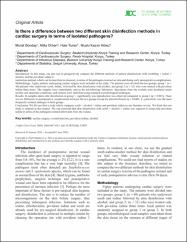Is there a difference between two different skin disinfection methods in cardiac surgery in terms of isolated pathogens?
Özet
Introduction: In this study, our aim was to prospectively compare the different methods of patient disinfections with scrubbing + iodine + alcohol, and the povidone iodine disinfection method, which can be described as classical, in terms of the pathogens isolated on skin and during early postoperative complications. Methodology: Eighty patients undergoing a coronary artery bypass operation were included in the study. The patients were divided into two groups: group 1 (n = 48) patients who underwent scrub, iodine, followed by skin disinfection with alcohol, and group 2 (n = 32) who were treated with povidone iodine three times. The samples were immediately sent to the microbiology laboratory. Specimens from the wounds were incubated under aerobic and anaerobic conditions, and isolates were identified using standard microbiological techniques. Results: In samples taken after disinfection in group 1, significantly less reproduction was observed compared to group 2 (p = 0.001). There was no difference in postoperative complications between the two groups except for pleural effusion (p = 0.040). S. epidermidis was the most frequently isolated pathogen in both groups. Conclusion: We did not find a study which compares scrub + alcohol + iodine and povidone iodine in our literature review. We think that our study is original in this respect. We can conclude that skin disinfection with scrub + alcohol + iodine was superior to using only povidone iodine in terms of the pathogens isolated afterwards from the wound.
















